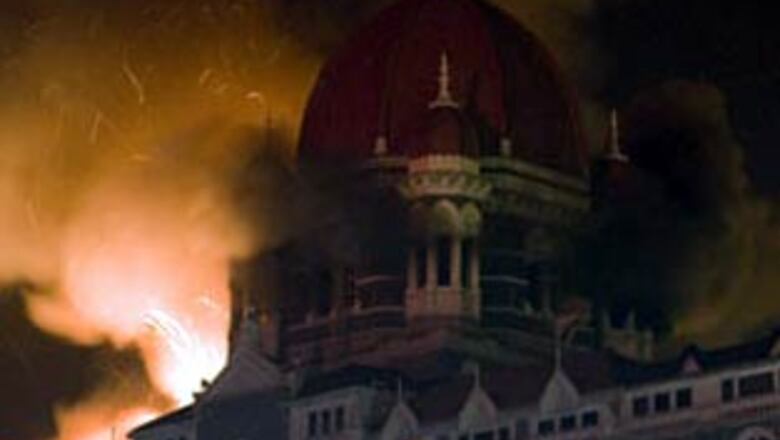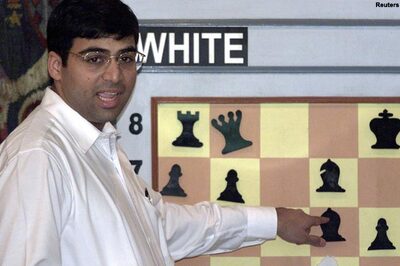
views
When terrorists entered the Taj Mahal Palace and Tower heritage wing and sprayed the grand staircase with gun fire, the Sea Lounge and Ballroom on either side were devastated. In the centre of the staircase, the iconic hotel's founder Jamsetji Tata looked on stiffly. But throughout the entire ordeal, the marble bust of the man remained unscathed.
"If you had seen what the place looked like, you would not have believed it," says Senior Vice-President, Sales and Marketing at Indian Hotels Company Limited (IHCL), Taj's parent group, Ajoy Misra. "There are many legends among the staff that Tata is the protector and preserves the Taj. The bust adds to that legend."
While Tata's bust was left untouched, most of the rest of the Palace heritage wing was decimated on 26/11 and the days after. The hotel that had withstood a great earthquake in the early 1900s, a fire and bomb in the port areas in the early 1940s, and acted as a hospital during the First World War could not withstand this sort of attack.
Historic Moorish and Florentine architecture, hundred-year-old and 1960s art deco design, as well as notable artworks were damaged beyond recognition. The country's first licensed bar, first Sichuan restaurant, and most iconic sushi joint were badly hit. The art deco ballroom, elaborate suites given to top industrialists and heads of state, and the sixth floor that housed the general manager, too, were burned or otherwise destroyed.
The Taj senior management's first reaction: Fix everything, as soon as possible. Nineteen days after the attack, on a chilly day in December, the Taj reopened its doors to the public. In the newer Tower wing, all services were restored. The hotel served all five of its cuisines to guests, even if the restaurants were no longer there. Wasabi was recreated on the rooftop. Shortly after, the Aquarius poolside lounge, Masalacraft restaurant, and the retail corridor were reopened.
Meanwhile, IHCL Vice-Chairman R K Krishna Kumar promised that in one year's time, the heritage wing would be "fully restored to all its glory".
Shutting Down the Old Lady
Earlier this year, Taj did manage to reopen parts of the heritage wing. In March, it reopened the Crystal Room Banquet Hall. In May, it reopened the Sea Lounge, a romantic spot overlooking the Arabian Sea where many have proposed on the special engagement couch.
But one year after Krishna Kumar's assurances, the rest of the heritage wing remains closed. Guests from abroad staying in the 106-year-old Taj Hotel are now placed in the 36-year-old Tower wing.
For good reason. The senior management's first reaction to the attacks was to just restore what was damaged. Repair the bullet holes, remove the burn marks from the walls, and erase the smoke stains from damaged art.
But then they had an idea.
What if instead they took this opportunity to restore the entire heritage wing, much in need of restoration? "We took a call, should the grand old lady shut down? The hotel had never shut down, only been renovated in parts. But we knew we could relook at everything we ever wanted to do," says Misra.
They decided to shut the Palace heritage wing, for the first time in 106 years. "We got the best of the world's designers, contractors, and architects to recreate this wing and reopen it. We decided we want to change our position in the world of hospitality," says Misra.
And change it they are. Over the past year, Taj has received an on-account insurance payment of Rs 130 crore, and it has spent far beyond that number, says Misra. He declines to give the exact amount.
One thousand people are together restoring 300,000 square feet of the heritage wing. The number includes 20 design consultants from around the world, 45 contractors for new services like plumbing and wiring, and 600 construction workers. Add to that the 35 IHCL senior staff, who are actively involved; an art restoration team and consultants; and perhaps most important of all, brand new security services from consultants in Israel and the United States.
Picking up the Pieces
But the process has not been easy. International consultant Archetype Group, which was given the mammoth task of the restoration process project manager but came on board only in April, said this project has been its most unique and challenging yet.
Cyril Jacob, managing director of Archetype (India), enumerates the challenges: "Restoring a heritage building like the Taj has many surprises. Every opening of a ceiling or partition leads to the discovery of an unexpected slab or wall that needs to be accommodated in the design."
PAGE_BREAK
No doubt, the Taj has intentionally made the process a meticulous one. Before starting, it looked at benchmark hotels around the world like the Peninsula in Hong Kong and George V in Paris. Designers and contractors were chosen by their previous experience with the hotel, but were given briefs and had to compete for those projects. Ergonomical inputs also came from management staff. The Mumbai Heritage Conservation Committee visited often to make sure Taj was preserving its architecture.
"This is not an ordinary building. This is not an ordinary hotel. We wanted to redo everything, to give the world a new chapter after 26/11, but also respect the iconic structure of such a place. We had to spend a lot of money to make it contemporary, but retain the old world charm." says General Manager of the Taj Hotel Karambir Kang, who lost his wife and children in the attacks last year when terrorists stormed into his sixth-floor apartment.
Money was one thing, but the challenges quite another. Design briefs were not finalised until months after the attacks. The sheer scale and complexity of the project made it nearly impossible to finish in a year. And because it is a heritage structure, James Park Associates, an interior and product design consultancy based in the UK, says there were challenges they would never face in a modern hotel, such as 80 different room configurations in 280 guest rooms.
Milan-based architecture and design firm Lissoni Associati, which designed three suites, tells this story: "One day Lissoni's team had to re-design an entire suite because the original drawings showed a door when actually it was a solid wall, causing a delay of at least a month."
Every design brief also needed to present a room that was timeless, yet modern. How do you put a flat screen TV in a heritage room? Restorers ran the risk of angering long-time patrons, so they had to strike a careful balance between old and new. And in such a short time period with so many people working in tandem, even one mistake would cause a ripple effect.
Somehow, all of those challenges have and are being faced. And by April 2010, IHCL says the entire heritage wing will be open to the public. Designers and project managers confirm the date. "It was clear from the beginning that no delay would be accepted. But speed could not be at the expense of security, quality, or safety," says Jacob of Archetype Group.
Dinner's on the Table
Recently, Taj patrons got to see the first real fruits of the restoration labour. The three most damaged restaurants - Harbour Bar, Wasabi, and Golden Dragon - have reopened their doors, as well as updated their cuisines.
The Rockwell Group Europe, a Madrid-based architecture and design firm was just about to start a planned restoration of the hotel's Tower wing when the attacks happened and the restaurant restoration fell onto its plate.
"Our brief dramatically changed. We were given less than a year to open Wasabi and Harbour Bar from scratch. Getting a high-end concept done like this in less than a year is very aggressive." says Managing and Creative Director of Rockwell Group Europe, Diego Gronda.
Taj senior management decided that Wasabi, the beloved sushi spot gutted in the attacks, should completely change design-wise. As for Harbour Bar, the restoration wasn't as easy. When Rockwell Group, gave its first presentation, the senior management gave a lot of negative feedback. But Harbour Bar's previous timid entrance was finally transformed into a large marble portal that "gave a real sense of arrival to such an historic bar," says Gronda. The bar with license number 0001 in its new avatar is all bronze and leather and marble.
LTW, a design firm based in Singapore that also worked on Taj's restaurants, had finished a renovation of the heritage wing just six years earlier. Jeffrey Wilkes, partner at LTW, was in Mumbai on another job when he saw his hard work go up in smoke. "I asked Taj immediately, ‘What's your game plan?' and we gave whatever drawings we had earlier," he says.
LTW was asked to come back and restore the Sea Lounge. It knew from the previous restoration to keep the floor plan the same. So it mostly just restored the room and freshened the colours. It was also commissioned to do a major freshen-up of Golden Dragon, which now boasts a much hipper avatar than its previous art deco feel.
Rooms at the Top
The biggest project of all, the heritage wing's 280 guestrooms, was given to James Park Associates (JPA), which has been working with the hotel since 1999 on heritage properties. This January, guests will once again inhabit those rooms. Taj has already taken bookings on request, though that hasn't been publicised.
Managing Director of JPA's Singapore office, David Edwards, says the rooms haven't been an easy task. "In an old building like this, perhaps once upon a time the rooms were a regular size, but now there are so many configurations. And thick masonry makes it impossible to reconfigure."
With so many layouts, JPA also decided to do many distinctive interiors. While the rooms aren't opening on their November deadline, Edwards says it was because the hotel decided to address everything, from services to creation of new spaces. "It's really rare a hotel has the opportunity to take on a renovation of this scale. It's also because the senior management, Krishna Kumar and [Ratan] Tata had such a level of interest."
And in the ballroom, where a lone gunman once turned off all the lights, LTW designers are hard at work to restore it by March 2010. The first time LTW decorated the ballroom, it did it from old deco photographs. "This time, we are going back to the old Victorian, Edwardian style ballroom, like the original Taj ballroom that once existed long ago," says Wilkes.
PAGE_BREAK
Suite Success
March will also see the opening of what Taj's most pre-eminent guests are waiting for - the suites. Sixteen themed suites have been massively redone, many renamed. The Presidential Suite, for example, has now become the Tata Suite, and expanded to include three bedrooms, a conference room, living room, dining room, and spa.
Will guests mourn the changes to the suites in which they've often stayed? "Whenever there is a makeover you will lose a part of what was old. Ten to 12 years back when we redid the hotel, there was a strong reaction of ‘what have you done?' But people accept that we have to keep introducing new things to keep it current, as long as you don't lose the soul or essence of the place," says Kang.
To ensure that patrons would be satisfied, the hotel staff went over years of customer comments and took the opinions of their regulars through an informal feedback process. "There is the old guard who wanted to retain what was there, but the customers' average age is getting younger, so we were guided by both," says Kang.
New suites have also been added. Most anticipated is the Ravi Shankar Suite, dedicated to the classical musician who used to jam out with Beatle George Harrison in that very room. The room will include Shankar's old sitar, art work from his favourite artist Jamini Roy, and memorabilia items like concert programmes, album covers and photographs. Other new suites include the Gateway of India Suite and Maratha Suite.
Designing the suites while running a fully operating hotel presents its own challenge, says Jacob of Archetype. Many times workers had to manually piggyback material and debris up five floors of narrow staircases so as not to disrupt patrons. The suites also required an immense amount of co-ordination between the international and local designers, which required videoconferencing and time difference planning.
Matters of the Art
The art restoration process, under the care of Mortimer Chatterjee of Chatterjee and Lal Gallery, which has been an art consultant for the Taj for many years, has also been a meticulous one. His task: To see which of the Taj's 4,000-piece collection were destroyed, which could be restored, and which works they could bring out anew that the public had never seen.
"The limited damage to the art collection seems to be subject to fate," Chatterjee says. He explains that prior to last November, most of Taj's important works were put into storage for a planned restoration. "Because of this, there were very few losses, as key works had been kept safely away. The management also had to taken the decision to put all canvas behind glass, which kept the paintings safe even if the frames were destroyed."
While new works were commissioned for the restaurants, most of the rooms and corridors will soon display artwork that's always been part of the Taj collection but patrons have never seen.
The suites will get all new works. "The second and third floors, which look strangely like a gallery with long straight walls and the seating of a gallery outside of the elevator, may have thematic floors with the different regions of Indian, such as folk and tribal works on one floor and Gujarati textile on another," says Chatterjee.
Getting Her Back to Life
Almost every designer and restorer the Taj brought on board in 2008 has worked for it before, and has a distinct memory of ‘the grand old lady'.
Steve Henry, the principal-in-charge of the Taj Mahal Palace project for BAMO, an American architectural firm that worked on several suites certainly has. A few years ago, sitting in the lobby of the Taj Palace wing, Henry overheard a very young businessman agitatedly talking to the concierge. The young businessman said it was his first time staying in the heritage wing and wondered how he could have not stayed there before. Henry says when he heard the young businessman's remarks he realised just how much the historic property meant to its guests.
And when the heritage wing's year-and-a-half-long, Rs 130 crore-plus, 1,000-worker-strong restoration is finished in April 2010, restorers say it will all be worth it. The hotel's patrons are already keeping the faith - this month, Taj had 85-90 per cent occupancy, and has seen visits from the crown prince and princess of Spain, George Bush, and Indriya Nooyi of Pepsico.
"We are overwhelmed by the solidarity," says Misra. "We can't wait to open the palace heritage wing. That is what all the customers are waiting for."
And it's what Jamsetji Tata seems to be waiting for too, his bust patiently overlooking as the hotel he founded more than a hundred years ago is finally brought back to life.

















Comments
0 comment